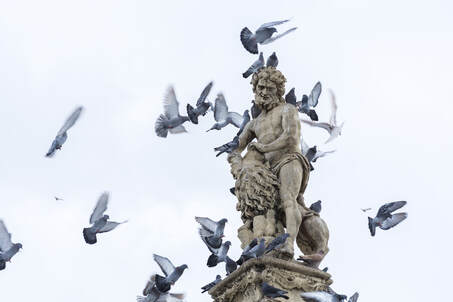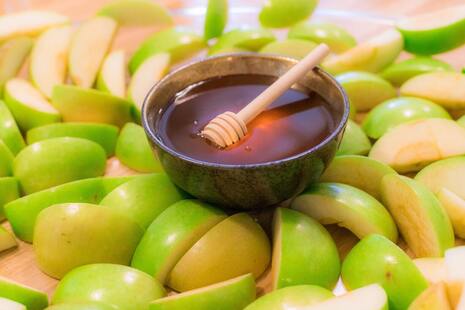In Hebrew, “bee” is translated with Deborah, which is the name of two important women: the nurse of the matriarch Rebecca and the prophetess Deborah (1107-1067BCE). Deborah was the fourth Judge of pre-monarchic Israel and the only women among them.
Since beekeeping is not described in the Torah, honey was long understood to mean date syrup or honey of wild honeybees. However, archaeological findings of beehives in the Jordan Valley that are more than 3,000 years old challenge these interpretations. One thing is clear: the Torah describes wild honey as one of the finest foods, which also plays an important role in the story of Samson’s riddle:
Since beekeeping is not described in the Torah, honey was long understood to mean date syrup or honey of wild honeybees. However, archaeological findings of beehives in the Jordan Valley that are more than 3,000 years old challenge these interpretations. One thing is clear: the Torah describes wild honey as one of the finest foods, which also plays an important role in the story of Samson’s riddle:
|
The sweetness of honey
The natural sweetness of honey is used to symbolize the sweet aspects of life and is eaten in pastries and on various holidays, such as Rosh Hashana, the Jewish New Year. Celebrants dip apple slices into honey followed by the recitation of a prayer for a good and sweet year. The honey here symbolizes the hope for a happy and prosperous new year. In the Midrash (the biblical commentary on the Scriptures), honey is a metaphor for the sweetness and wisdom of the Torah. For example, in King Solomon’s verse, “honey and milk under your tongue”, honey represents the sweetness of the words of the Torah. Accordingly, honey and milk are also consumed on the Shavout holiday, celebrating the Giving of the Torah. The Talmud also provides several hints on the positive effects of honey, such as restoring vision or improving memory. |
Shortly after killing a young lion with his bare hands, Samson found a swarm of bees living in the carcass of the lion and ate from the honey they had produced. Shortly thereafter, at his wedding feast, Samson told the audience the following riddle: “Out of the eater came something to eat, and out of the strong came something sweet” (Judges 14:14). The guests, driven by the desire to win the promised prize, pressured the bride to find out the solution. After begging to her newly wed husband, he gave her the answer: “What is sweeter than honey? What is stronger than a lion?” (Judges 14:18). The bride told the guests but Samson soon realized he had been deceived. Enraged, he left the wedding and the bride was married to another man.
|
The bee itself belongs to the class of unclean insects, so normally the rule “that which comes from something which is tameh [non-kosher] is tameh,” (Bek. 1:2) should apply to honey. However, rabbis claimed that honey is only stored in the bee’s body and is therefore not a product of the bee itself. Thus, honey and other bee products are considered kosher.
For more reflection on bees and Judaism check out this speech on bees and Judaism given by Dr. Deborah Williger (Institute for Theological Zoology) at our award ceremony.
For more reflection on bees and Judaism check out this speech on bees and Judaism given by Dr. Deborah Williger (Institute for Theological Zoology) at our award ceremony.


